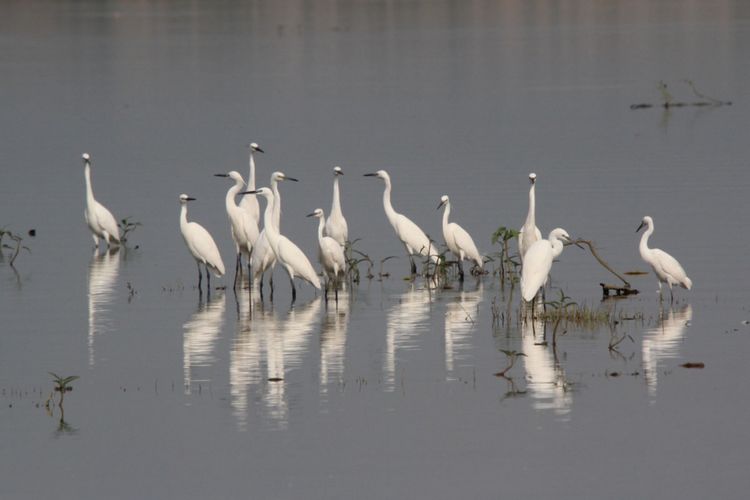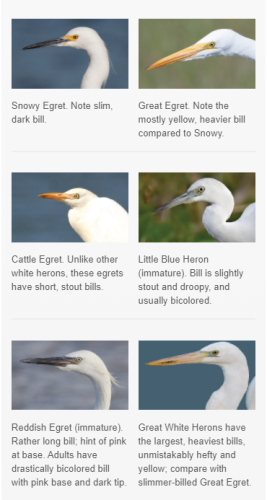Kuntul and Bangau

Photo Credit : Rosyid Azhar
When we are in the water area, we often see white water birds flying in the sky or some are on the ground. Water bird is any bird that lives/inhabits areas in or around water bodies (both fresh and salt water). Another question is whether it is an egret or a stork? They look the same because they are biologically in the same family.
The easiest way to distinguish between a Bangau (Ardeidae) and a Kuntul (Ciconiidae) is by its color. Bangau can have a varied color of feathers, while egrets are more likely to be white or fluffy. In addition, although egrets do not have feather trimmings as seen on herons, they display beautiful feather breeding that is unique to their species.
One of the most famous species of egrets is the white egretta (Egretta alba), which is also known as the great egretta or great white egret. This bird has a striking white plumage, a yellow beak and long black legs. White egretta can be found in a variety of freshwater and saltwater habitats around the world. In addition to white egretta the genus Egretta also includes several other species, such as Chinese Egretta (Egretta eulophotes), Little Eegretta (Egretta garzetta).
Types of herons that are often found in coastal areas are Bangau Bluwok (Mycteria leucocephala) and Bangau TongTong (Leptoptilos javanicus).
Widespread throughout the world, except in polar regions, heron and storks are commonly found in a variety of aquatic habitats, including swamps, lakes, rivers, rice paddies, and coastlines. This bird feeds on various types of prey, mainly fish, but also insects, amphibians, reptiles, and small mammals.
These water birds have an important role in aquatic ecosystems. They help maintain the balance of fish and other aquatic animals by preying on small animals around the waters. Great egrets also have high aesthetic value and are often used as symbols.
Since cranes and egrets have no biological differences between them, the lines between these species can easily become blurred. This article will provide a summary of the differences between egrets and heron.
|
Classification |
Heron |
Stork |
|
Kingdom |
Animalia |
Animalia |
|
Phylum |
Chordata |
Chordata |
|
Class |
Aves |
Aves |
|
Subclasses |
Neornithes |
Neornithes |
|
Infraclass |
Neognathae |
Neognathae |
|
Superorder |
Neoaves |
Neoaves |
|
Order |
Palecaniformis |
Ciconiiformes |
|
Family |
Ardeidae |
Ciconiidae |
Heron species found in Indonesia:
- Bluwok Stork (Mycteria leucocephala)
- TongTong Heron (Leptoptilos javanicus)
- Stork Storm (Ciconia stormi)
Stork species found in Indonesia:
- Little Egret (Egretta garzetta)
- Sea Kokokan (Butorides striatus or Ardea striatus)
- Red Hornbill (Ardea purpurea)
- Sea Shells (Ardea sumatrana)
- Silver Egret (Ardea intermedia, Egretta intermedia, or Mesophoyx intermedia)
- Sublime Egret (Ardea alba, Egretta alba)
- Buffalo Egret (Bubulcus ibis or Ardea ibis)
- Coral Egret (Egretta sacra or Ardea sacra)
The families Ardeidae and Ciconiidae are a family of waterbirds consisting of herons, bitter and egrets. Family Ardeidae is divided into 18 genera while Family Ciconidae has 6 genera namely Anastomus, Ciconia, Ephippiorhynchus, Jabiru, Leptoprilos, Mycteria. Today in the world there are still 43 species of storks, 15 species of bitter, and 9 species of egrets.
In the group of waterbirds, in addition to storks and egrets, we also know other species that have similar appearance and body structure, such as the Ibis and Spoonbill birds. These birds belong to different families and genera and have some or other differences that can easily distinguish them. Unfortunately, that's not always the case with storks and egrets.
The general morphology of this bird family is that it has a tall kai and a long beak, but in heron species the beak is wider/larger and stronger.
Below are the differences between egrets and storks:
- Body size

(Left to Right): Little Egret (Egretta garzetta), Grey Heron (Ardea cinerea) and Intermediate Egret (Egretta intermedia) (Photo Credit : Tan Rui Siang)

Asian Openbill Stork (Anastomus oscitans) (Photo Credit : Tan Rui Siang)
Herons and egrets have approximately the same body size. However, all the largest members of the Ardeidae family are storks. Herons of all species are between 75-152 centimeters tall and weigh 1.3-9 kg, while the largest egrets reach 100 centimeters in height with an average weight of 1 kg.
- Appearance

Photo Credit : All About Birds
The beak of these birds is shaped somewhat like a spear, which makes it easier for them to catch fish. The thickness of the beak can vary from species to species. Although both birds are quite tall, their height appears to be reduced due to their curved necks. Due to the modified shape of the cervical vertebrae, they have an S-shaped neck that can be retracted and extended at will.
Another important difference between these birds is the color of their plumage. The distinctive feature of egrets is that they have a white coat color while heron can have varying coat colors, some species of heron have two colors on the upper body for example the Great Blue Heron (Ardea herodias) that lives in North America.
Egrets usually have thicker necks than herons. In addition, six species of egrets are able to grow characteristic white fur during the breeding season.
Herons are more likely to have a crest than a feather. Lastly, all egrets have black legs, while stork feet are usually yellow. The egret's beak is also much lighter than the stork's beak.
However, a common difference between this bird and other long-necked birds is that they pull their necks while fighting, whereas others lengthen them. Both storks and egrets show little sexual dimorphism, with both sexes appearing equal, especially in the unmated season. Both birds have wide wings with soft plumage. Now that we've covered the basics of their appearance, let's explore the differences:
There are some other small differences between these water birds that can set them apart from other than their appearance. The first is diversity. Heron species are obviously larger in number than egrets, because heron has more diversity.
- Behaviour

Intermediate Egret (Egretta intermedia) (Photo Credit : Tan Rui Siang)
Herons are migratory animals, which is why they are much better at flying than egrets. Herons have a clean flight, while egrets are careless fliers. Their legs kept shaking throughout the flight. In terms of flight, these birds also differ from each other. When flying, the egret's neck will curve in an S-like shape, while the heronhas a straight neck with its legs stretched.
Herons do not have sound producing organs and they have a habit of preferring to nest at a certain height, such as the tops of trees. Their nests are known as "Heronries." On the other hand, egrets do not share such reservations and nest lower, closer to the ground.
These birds usually build their nests in bushes around shallow water. In addition, they may choose to nest in bushes as well, at a safe distance from water.
-YN

